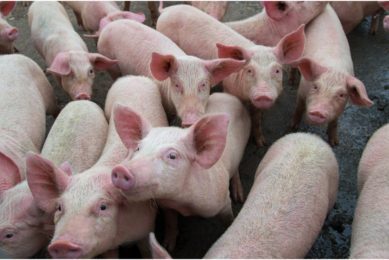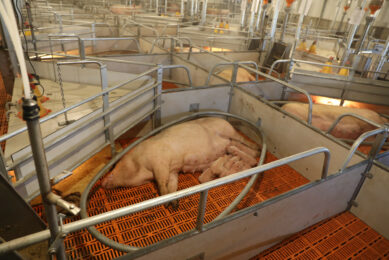What the textbooks don’t tell you about… Creep feeding (2) – what the experts do
My previous article on creep feeds gave reasons why it is essential these days to creep-feed piglets on the sow. They are more expensive, yes, but the payback (at slaughter) is three times more due to a better start. There is no point in investing in such sophisticated diets if they are not presented in the correct manner.
By John Gadd
“Starting early is a waste of feed”
The previous objections to creep feeding have been that starting the procedure too soon “only wastes an expensive food and the little piglets do not eat a measurable amount to make any difference.” Maybe this were true in the past, but not necessarily so today.
- Do not be concerned if the uptake of the creep is very variable between litters. It will happen, so do not let that put you off starting to offer creep as early as possible – a very small amount frequently replenished from as early as three days old. The latest creep feeds are extremely digestible so there is little gut disturbance at that age, always providing that the hygiene is of the highest order.
- The nutritionists say that in order to give the piglet the best chance of transferring smoothly from sow’s milk to solid food at weaning, about 400 g of creep feed should be eaten by then.
- Starting early with the right feed, presented properly, can provide 1 kg bodyweight difference at 46 days. This led to each piglet getting to slaughter three days sooner, providing 12-18 kg more saleable meat per tonne of growing food fed to slaughterweight.
“A lot of feed is wasted!”
Sure, piglets will waste a lot of food early on by just not eating it before the feed loses it’s ‘nose’ and has to be removed. Just give the uneaten creep feed to a thin sow or gilt and it will never be wasted.
“Creep feed makes pens filthy!”
This is where many fall down. Those who complain that the new creep feeds do not come up to expectations fail in this area of cleanliness. There are plenty of satisfactory creep starter containers which I see being used, but where people go wrong is that they are not being cleaned and replenished frequently enough.
The right moment…the ‘Three Threes’ concept
So how to offer creep feeding in the right way? This means that for the first three days, i.e. from day 3-4 from birth until day 6-7, the creep feed must be offered three times a day (during working hours) and only enough should be offered to last three hours. The containers must be cleaned each time as stale food and other detritus from the farrowing pen upsets the gut flora balance in favour of looseness. This is a heavy load on labour but time spent with the baby pigs is essential.
…with the right attention…
So how much time? I have done my own time-and-motion studies (in press) on how much time stockpeople in seven countries spend on various tasks and I see they are in accord with the more sophisticated surveys of Salaun in France and Hemmings in Australia. My observations suggest that typically, of the 50-58% of the time spent on the breeding section of a farrow-to-finish farm, only 2.9% was spent looking after sucklers in the farrowing pen. This is about 51 seconds per litter per day! This is far too little to keep the creep containers clean and fresh, replenish the feed frequently enough and check on temperature, water availability, etc. It should be at least three times as much. The best breeders allow this amount of supervisory time for the creep feeding period.
…in the right place…
This will vary according to the ground plan of the farrowing pen, but the following are advised:
- Where it is easiest reached for regular sanitation and replenishment. If possible in a place where it is not always necessary to go in and out of the pen so as to avoid transmitting disease.
- Not near to the wet elimination area of the pen and away from the sows urine splashings.
- Never under or too near a heat source, but as near as possible to where the piglets will rest.
- Actually in the covered creep area? No, it is usually too hot there.
- The creep container should be well lit – about 100 lux is sufficient.
- Clean fresh water must be placed between it and towards the edge of the elimination area. These new creep feeds – and what is not generally realised, sows milk itself – are very thirst-making. The little stainless steel mini-leaf drinkers are ideal.
…and in the right amounts
The creep containers should be small and low – shallow trays with a 1 cm lip are good if kept clean for the first 10-14 days of use, when a larger conventional creep hopper can be put in the pen. But not before, as these are always overfilled (just enough for 24 hours).
Some other tips
- The best time to introduce a small amount of creep pellets is about three hours after feeding the sow. This delay is because the sow tends to provide more milk for longer after her daily feed(s) and the piglets go to sleep. Wait until the piglets enter that ‘playful’ stage as at this time they are inquisitive to come and look at the container which has just been placed in the pen and sample the creep feed that is inside it (or on it, as some people use a flat tray).
- Piglets love potato starch. Try sprinkling a little on top of the pellets to tempt those litters which are slow to start feeding.
- Baby pigs have a sense of smell probably 40 times greater than ours. Never keep the creep feed bags in the farrowing house but in an insulated cool store – we used redundant ice-cream vans. Always open a new bag when starting piglets off for the first time.
- Do not order more than 14 days supply of creep feed and check that the manufacturer makes daily or two-day batches rather than only once in a while.











